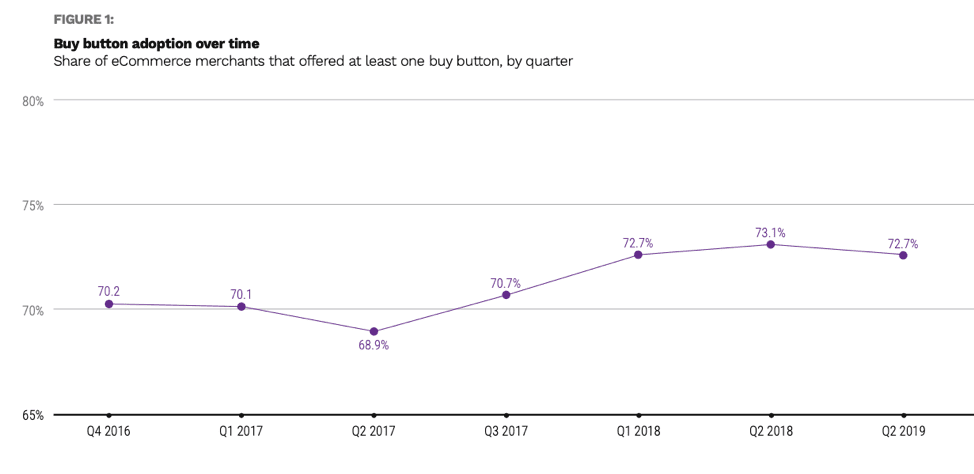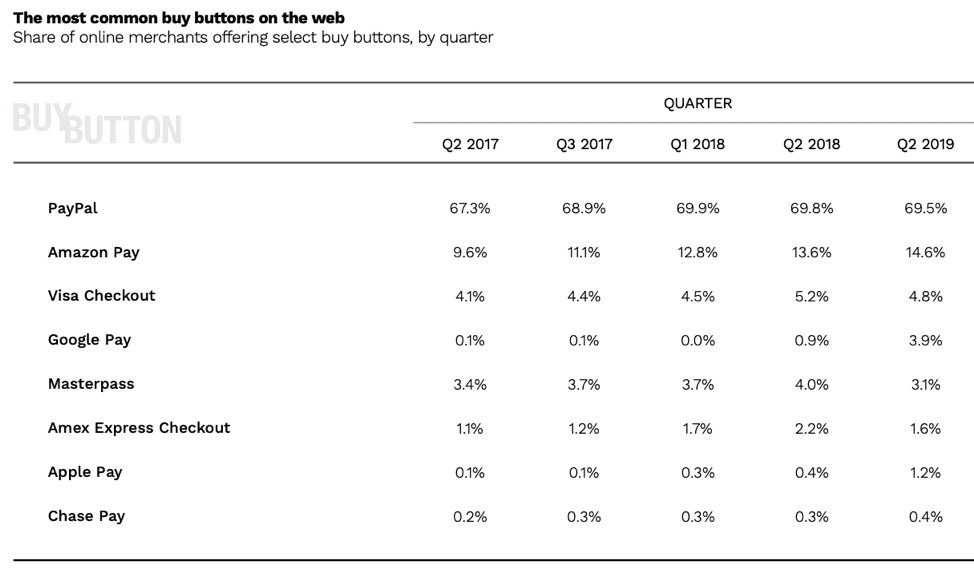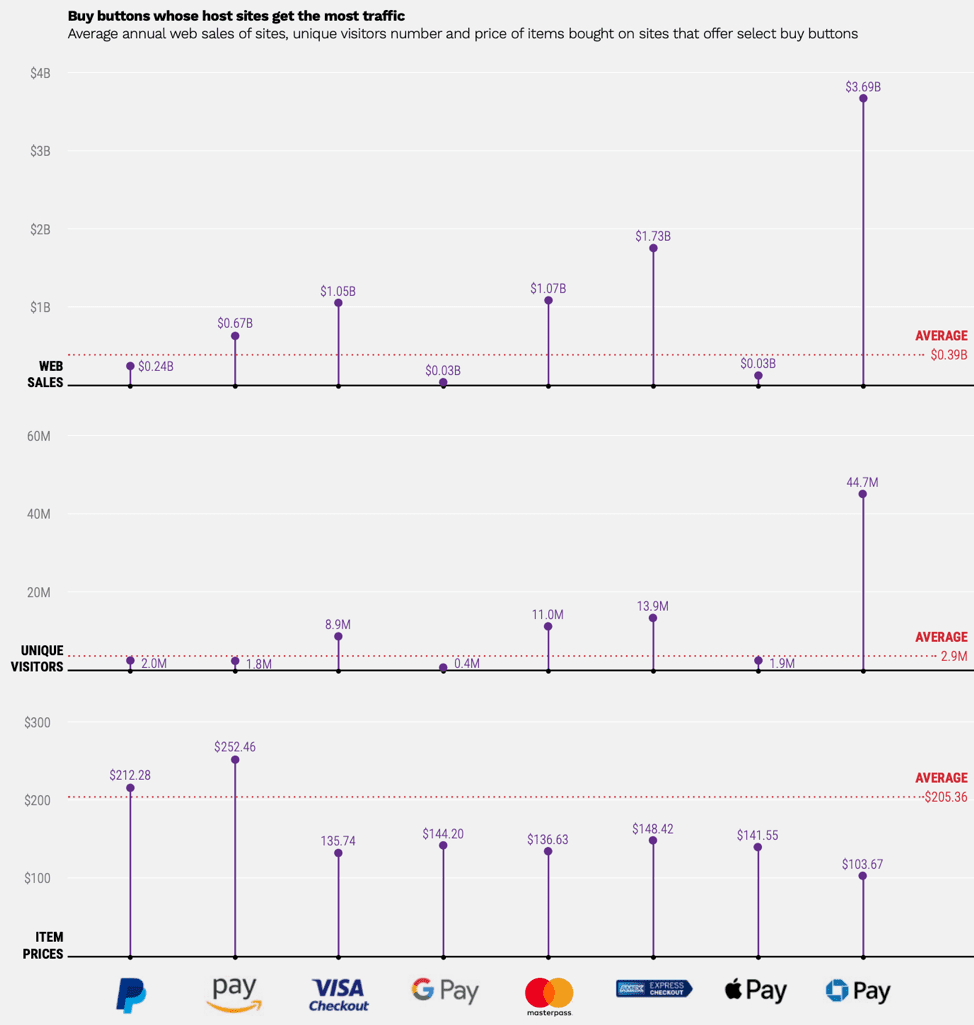Merchant Adoption Of Multiple Buy Buttons Growing

So-called “buy buttons” have captured the imaginations of online retailers and social media platforms over the years, but they have had far more success being used on eCommerce sites. Instagram encourages discovery and shopping, but has stopped short of adding a literal buy button, while Twitter has experimented with them but nixed the idea in 2017.
They are now so ubiquitous on eCommerce sites that the average shopper might not even notice them. According to PYMNTS’ Q2 Buy Button Index, more than seven in 10 leading eCommerce merchants now offer at least one buy button, and one in five now offer two or more.
Those figures have remained fairly steady, though, with no marked increase or decrease in the past few years. The share of merchants offering buy buttons rose slightly, from 72.7 percent in Q1 2018 to 73.1 percent in Q2 2018, but went right back to 72.7 percent by Q2 2019. The share also hasn’t changed significantly since PYMNTS started tracking buy buttons in Q4 2016.

Buy buttons are often branded. PayPal is currently the dominant buy button, and has been for the past two years. Their buy button is now offered by 3.7 times as many eCommerce merchants as the next most common, Amazon Pay.

Amazon Pay has seen a steady uptick in adoption during that time frame. Its buy button was supported by 9.6 percent of eCommerce sites in Q2 2017 and 14.6 percent in Q2 2019, an average of 11.2 percent growth. Google Pay has also seen an increase in adoption, to 3.9 percent in Q2 2019, while Visa Checkout is used by 4.8 percent of eCommerce sites, making it the third most popular.
These findings reflect that several major card networks have begun to shift their focus away from expanding their buy buttons and toward developing the new, more standard secure remote commerce (SRC) payments solution, a token-based system that allows consumers to securely store their payment data and prepopulate other information into forms on merchants’ sites, a process that kicked off in mid-2018.
In the study, higher adoption rates of particular buy buttons didn’t always translate to higher revenues. For example, just four eCommerce sites – 1800flowers.com,
ebags.com, United Airlines and Walmart – offered Chase Pay, but those merchants generate greater annual revenues ($3.69 billion) and attract more consumers (45 million) than average. This is likely a case of those specific retailers, including United Airlines and Walmart, which attract a large portion of digital buyers.

PayPal and Amazon Pay’s solutions are offered by far more sites with lower average annual revenues and fewer unique monthly viewers. Even so, PayPal’s and Amazon Pay’s buy buttons have the two highest average price per purchase of any group. PayPal is offered by 731 sites and the average price per purchase is $212.28, while Amazon Pay is provided by 154 sites with an average price of $252.46 paid by consumers for items.
The PayPal and Amazon Pay buy buttons are comparatively common on a large number of low-revenue sites with higher ticket prices.
Buy button usage also differs among retail categories. Home improvement has the highest number of sites using at least one buy button (87.3 percent), followed by electronics (80.3 percent) and ticketing (80.0 percent). Even categories like office supplies, which has the lowest adoption rate, are still used by 60 percent.
PayPal’s buy button is offered by no fewer than 63 percent of merchants in any sector, and is particularly common among automotive eTailers (83.3 percent). One-quarter of travel and hospitality sites offer Amazon Pay, twice that of home furnishings merchants (12.5 percent).
One of the most prominent findings from this study was that the share of eCommerce sites adopting buy buttons has largely been stable for the past two years. This isn’t a result of stagnancy, but the fact that over the past four quarters, some sites have been removing buttons while others have been adding them.
However, the most common number of buy buttons offered by merchants is still just one, with 51.7 percent supporting a single buy button option in Q2 2019.
Just 3.3 percent of all eCommerce merchants that had never offered buy buttons added one to their websites between Q2 2018 and Q2 2019, while 3.7 percent that had previously offered at least one removed them all. According to the study, this adding and removing did have an effect on revenues, which could serve as an actionable insight for many retailers.
Websites that had no buy buttons in Q2 2018 but added at least one in Q2 2019 experienced an average annual revenue of approximately $3.1 billion. This figure was just $59.4 million for those that had at least one buy button in Q2 2018 but had removed them all by Q2 2019.
